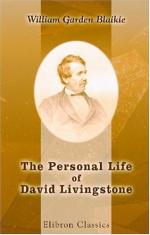“That lady,” he said, “was born with one distinguished name, which she had changed for another. She was born a Moffat, and she became a Livingstone. She cheered the early part of our friend’s earner by her spirit, her counsel, and her society. Afterward, when she reached this country, she passed many years with her children in solitude and anxiety, suffering the greatest fears for the welfare of her husband, and yet enduring all with patience and resignation, and even joy, because she had surrendered her best feelings, and sacrificed her own private interests, to the advancement of civilization and the great interests of Christianity.”
A more general meeting was held in the Mansion House on the 5th of January, to consider the propriety of presenting a testimonial to Dr. Livingstone. It was addressed by the Bishop of London, Mr. Raikes Currie, and others.
Meanwhile, a sensible impulse was given to the scientific enthusiasm for Livingstone by the arrival of the report of a great meeting held in Africa itself in honor of the missionary explorer. At Cape Town, on 12th November, 1856, His Excellency the Governor, Sir George Grey, the Colonial Secretary, the Astronomer-Royal, the Attorney-General, Mr. Rutherfoord, the Bishop, the Rev. Mr. Thompson, and others, vied with each other in expressing their sense of Livingstone’s character and work. The testimony of the Astronomer-Royal to Livingstone’s eminence as an astronomical observer was even more emphatic than Murchison’s and Owen’s to his attainments in geography and natural history. Going over his whole career, Mr. Maclear showed his unexampled achievements in accurate lunar observation. “I never knew a man,” he said, “who, knowing scarcely anything of the method of making geographical observations, or laying down positions, became so soon an adept, that he could take the complete lunar observation, and altitudes for time, within fifteen minutes.” His observations of the course of the Zambesi, from Sesheke to its confluence with the Lonta, were considered by the Astronomer-Royal to be “the finest specimens of sound geographical observation he ever met with.”
“To give an idea of the laboriousness of this branch of his work,” he adds, “on an average each lunar distance consists of five partial observations, and there are 148 sets of distances, being 740 contacts,—and there are two altitudes of each object before, and two after, which, together with altitudes for time, amount to 2812 partial observations. But that is not the whole of his observations. Some of them intrusted to an Arab have not been received, and in reference to those transmitted he says, ’I have taken others which I do not think it necessary to send.’ How completely all this stamps the impress of Livingstone on the interior of South Africa!... I say, what that man has done is unprecedented.... You could go to any point across the entire continent, along Livingstone’s track, and feel certain




